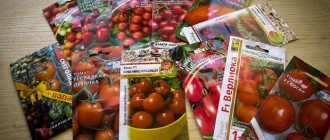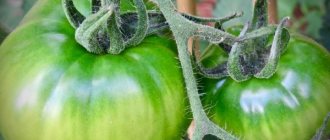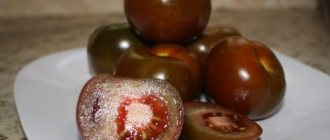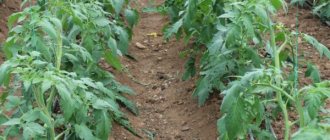Question: Why do tomatoes crack? Let's find out!
According to British scientists, the tomato is the healthiest vegetable in the world. These cute tomatoes contain a huge amount of vitamin C. Regular consumption of vegetables will significantly reduce the risk of malignant tumors and strengthen the cardiovascular system. And besides, it's very tasty. In general, it is not surprising that in almost any country house there is a place for tomato seedlings.
Another thing is that even the most experienced summer residents sometimes have incidents. For example, tomatoes crack on the bush. Is this problem as serious as many people think? Is it necessary to deal with cracks? Are all varieties prone to cracking? First things first.
Are cracks in tomato fruits dangerous?
Loss of integrity of the tomato skin leads to rotting of the fruit. Fungal spores enter the fruit through cracks. In conditions of high humidity in the greenhouse, mold and rot develop. Plants with bursting fruits become breeding grounds for diseases in the greenhouse.
When inspecting the plantings and finding burst fruits on the plants, they are immediately removed. Ripe tomatoes are processed (ketchup, tomato sauce), green tomatoes are disposed of.
Advice. A small crack in a green tomato can be thickly sprinkled with salt and the fruit can be left to ripen. The salt will close the wound and prevent mold from developing. The tomato will ripen without damage and can be eaten.
If the crack in the tomato is small, it may heal on its own. But an ugly scar will remain on the skin. If tomatoes are grown for sale, such fruits have a low price due to their poor presentation.
4. A network of cracks around the top of the tomato fruit
The network of cracks around the top of the tomato fruit are misshapen fruits with scars and lines that often radiate from where the flower attaches to the fruit. Cracks form at the base of the tomato fruit, through which the seed chambers are visible.
Why tomatoes burst on a bush in a greenhouse: reasons and how to deal with it
To effectively combat cracking of tomatoes in a greenhouse, it is necessary to determine the cause of the problem. In most cases, the reason is a violation of the rules for growing crops.
Violation of the watering regime during ripening
Tomato is not as moisture-loving plant as cucumber. But it also requires moisture, especially during the period of active fruit filling. With insufficient watering, tomatoes form in smaller quantities and are small, but with excess moisture, tomatoes suffer from rot. A golden mean is required - watering tomato bushes during the fruit-filling phase is carried out 3 times a week, 8-15 liters per plant.
Read more in the article: How often to water tomatoes in a polycarbonate greenhouse
Violation of the regularity of watering, when the period of “drought” is replaced by an abundant supply of moisture, leads to cracking of the tomato skin. Often, a gardener comes to the site only on the weekend and begins to “water” the plants, trying to give them the water quota for the entire past week. The plant intensively absorbs moisture, causing the fruits to sharply increase in size and their skin cannot withstand it - it bursts. You can find cracked tomatoes on the bushes the very next morning after abundant watering.
There are several ways to smooth out differences in soil moisture and avoid cracking tomatoes from improper watering:
- install a drip irrigation system in the greenhouse;
- mulch the surface of the bed with tomatoes with mown grass and chopped straw;
- do not exceed the recommended dose of one-time watering, even if the tomatoes lack moisture.
Genetic cause
Tomato varieties that have thin skins crack more than pickling tomatoes with thick skins.
On a note. It has been noticed that tomatoes with a yellow fruit color are more susceptible to cracking due to a thinner shell. Red, pink and brown tomatoes have thicker skin.
When growing crops for sale, you should select varieties with elastic and dense fruit skin. Thin-barked varieties are planted in small quantities, paying special attention to their agricultural technology.
Incorrect application of fertilizing and fertilizers
An imbalance in the supply of nutrients to the plant leads to cracks in the fruit. As a rule, they are not as deep and large as when the watering regime is violated, but no less dangerous.
According to the growing rules, tomato bushes in the greenhouse are fed several times:
- nitrogen fertilizers at the beginning of cultivation, when there is an active growth of green mass;
- phosphorus-potassium and microelements during flowering and fruit set;
- complex mineral fertilizer containing all the main elements (nitrogen, potassium, phosphorus) at the stage of crop ripening.
If you exceed the recommended dose of fertilizer or fertilize more than once every 15 days, the flow of nutrients will be too active. All plant tissues rapidly begin to grow, causing not only the skin of the fruit to burst, but also cracks to appear on the stem.
A similar effect on plants appears when there is an excess of nitrogen in the fertilizer. This element is responsible for tissue growth and is useful in the early stages of tomato plant development. During the fruit ripening phase, the proportion of nitrogen in the nutrient mixture should not exceed 15%.
To protect tomatoes from cracking, during the harvest period they are sprayed with calcium preparations, for example calcium nitrate (40 g of the preparation per 10 liters of water).
Read more in the article: How to feed tomatoes during flowering and fruiting in a greenhouse
Diseases and pests
Damage to the skin of a tomato on a bush can be caused by the following diseases:
- Alternaria blight, caused by a fungus;
- late blight;
- gray and blossom-end rot, leaving marks on the fruit that look like wounds from cracking.
Against these diseases, tomatoes are treated with fungicidal preparations: Bordeaux mixture, karbofos. Trichodermin, an infusion of garlic, is used on fruiting bushes.
To prevent the occurrence of diseases in the greenhouse, at the end of the vegetable growing season, you should remove all plant debris and remove the top layer of soil from the beds. The walls and ceiling of the structure are washed with soap or a special disinfectant.
Insect pests such as aphids can gather on open wounds of tomato fruit.
Read more in the article: Diseases and pests of tomatoes: description with photos and methods of treatment
Disturbance of the microclimate in the greenhouse
Sharp changes in day and night temperatures in the greenhouse also lead to cracking of tomatoes during ripening. If the daytime temperature exceeds 30 degrees, and at night it drops to +10, the appearance of cracks on the fruit is inevitable.
To eliminate the temperature difference between day and night in the greenhouse, ventilation is used during the day. During the day, they open the windows and doors, creating a draft, and close everything at night. For ease of maintenance of the greenhouse, you can install automatic hydraulic or pneumatic opening of the vents.
Hot weather
In the summer sun, the temperature inside the greenhouse can rise to 40 degrees or higher, despite the open windows and doors. Tomato plants can suffer heat shock and sunburn of foliage and fruit. In addition to the characteristic white spots, wounds and cracks may appear on the fruits.
Watering plants in hot weather with cold water often leads to cracking of the fruits.
To protect the tomato bushes in the greenhouse from overheating, the walls and roof are whitewashed with lime from a spray gun. You can curtain the tomatoes with a special net, providing light shade.
How to avoid cracking tomatoes
To avoid cracking of tomatoes in a greenhouse and in open ground, you need to remember the rules for growing tomatoes.
- Watering tomatoes should be carried out systematically: in hot summers - every 3 days, in cloudy periods - once every 5-7 days. The best option is to create a drip irrigation system that will maintain a constant level of moisture in the soil.
- Mulching will protect the soil from drying out quickly. Mown grass, straw, and other materials are suitable as mulch.
- In hot weather, do not forget to ventilate the greenhouse. Keeping vents and, if necessary, doors open will reduce excessive temperatures. Shading the bushes, for example, with spunbond, which stretches near the roof, protecting the plants from the scorching sun, can also help in this situation.
- Choose varieties that are resistant to cracking. The most famous of them are Nasha Masha, Podmoskovny, Favorit, Vasilievna, etc.
Take a close look at your cracked tomatoes. Perhaps you just made some mistake in agricultural technology, so they burst? We hope our tips will help you avoid this problem in the future.
Why do green tomatoes burst on a bush in a greenhouse?
Green tomato fruits have thicker skin than ripe ones, but they can also burst. The reasons for this phenomenon lie in violation of the irrigation regime, temperature fluctuations in the greenhouse and incorrectly selected feeding regime.
As a rule, cracks on green fruits are small and heal on their own. But severely bursting fruits should be torn off and disposed of.
Let's prevent tomatoes from cracking: proper prevention
So, we already know the enemy by sight, we know why the trunk of tomatoes, unripe and ripe fruits crack. Now you can move on to proactive steps to prevent the problem.
What can be done to ensure that tomatoes grow and ripen beautiful, healthy - so that any dish, be it adjika or salad, is guaranteed to be tasty and healthy? You need to follow simple rules.
An important point is proper watering. It was easy to conclude from what was written above that it is the excess water in the fruit that leads to the appearance of cracks. Water your tomato beds sparingly but often, and at harvest time your tomatoes will give you smooth, healthy sides. In hot weather, plants need to be watered once every three days (at the rate of 3-4 liters of water per bush); in cloudy weather, the number of waterings can be reduced to once every five days. During periods of frequent rainfall, keep plants under cover to prevent them from absorbing excess water. And mulching will help solve (at least partially) the problem of drought - mulch retains moisture in the soil, which means that tomatoes will not suffer from water deficiency.
Other ways to prevent the disease include temperature control (a comfortable temperature for tomatoes in a greenhouse is 20-22 °C during the day and 16-18 °C at night), ventilation, and sun protection. And, of course, special attention should be paid to the selection and application of fertilizers (plants need to be fed every two weeks).
Follow these simple steps and you won’t have to look for the answer to the question of why tomatoes crack on the bush.
Preventive actions
By analyzing the reasons for the appearance of cracks on tomato fruits in a greenhouse, cracking prevention is carried out on the plantation. It consists in providing plants with stable and comfortable living conditions.
- Regular, moderate watering with not cold water will allow plant tissues to grow evenly. An automatic drip irrigation system is installed in the greenhouse. Water heated in the sun from the container by gravity or using a pump flows through polyethylene arms or hoses directly to the plants. Through the holes in the tubes, water drops dropwise onto the soil into the root zone.
Thanks to the drip irrigation system:
- makes caring for plants easier;
- water for irrigation is saved (up to 35%);
- warm liquid flows slowly, without eroding the soil at the roots.
In combination with drip irrigation, it is effective to use mulching of a tomato bed. A layer of mulch of 10-12 cm keeps the ground under the bushes moist and protects the roots of the plant from overheating in hot weather.
- Provide tomato plants with a temperature range of + 18 to +28 degrees, protecting them from sudden changes. An automatic ventilation system is installed in the greenhouse if the gardener visits the site intermittently. If the greenhouse has daily access, it is necessary to close the windows and door at night and open it in the morning.
Advice. If the walls of the greenhouse are made of film, you can roll it up and lift it on a hot day, exposing the plants to the wind. When it gets colder, the film is lowered again.
In June, when the summer heat season begins, the walls and ceiling of the greenhouse are covered with a special mesh or whitewashed to create light shade.
- Correct formation of a tomato plant is a good prevention of fruit cracking. When pinching out stepsons and trimming unnecessary foliage, the work should be carried out in several stages, removing the green mass gradually. At a time, a tomato is removed from 15-20% of its greens, no more. If you radically cut off the bush, the roots will not be able to quickly adapt to supplying less water and nutrients to the above-ground part. The food, instead of leaves, will suddenly go into the fruits and they will burst.
- Tomato plants are given a strict feeding schedule, according to the requirements of the crop. During the period of filling and ripening of fruits, a tomato needs in equal measure all three main elements (nitrogen, potassium and phosphorus). Fertilizers are applied no more than once every 12-14 days, observing the solution concentration recommended on the package with the drug.
- Greenhouse tomatoes are more susceptible to diseases than ground tomatoes due to intensive fruiting. Preventive fungicide treatments should be carried out before flowering. At the time of flowering and fruiting, tomato bushes are sprayed with garlic, tobacco or wormwood infusion. Folk remedies are suitable for the prevention of late blight and other tomato diseases, and do not contribute to the accumulation of hazardous substances in the fruits.
By regularly inspecting the plants in the greenhouse, you can spot signs of fruit cracking early and take steps to correct the problem.
What varieties of tomatoes do not crack?
variety De Barao
Strictly speaking, the skin of the fruit of any tomato variety can burst due to violation of the rules of care. But there are varieties that are resistant to cracking.
Basically, these are modern hybrids and varieties:
- Lady's fingers (a variety for preservation that has medium-sized pear-shaped fruits);
- Bohemia (hybrid with large (120-130 g) fruits, suitable for storage and transportation);
- Rio Grande (plum-shaped fruits are good for pickling, heat-resistant variety);
- Vladimir (first generation hybrid, producing large, dense and fleshy fruits).
- The old, time-tested De Barao is also considered a crack-resistant tomato variety.
You can also select other varieties that are not prone to cracking: Nasha Masha F1, Hercules F1, Pink Honey, Harlequin.
Varieties not prone to cracking
The best varieties of tomatoes that cannot crack even with temperature changes, excessive moisture and other negative factors:
- Cardinal - mid-early ripening. The height of the bush is up to 170 cm. The fruits are large, fleshy, weighing from 200 to 600 g. The vegetable is characterized by a long shelf life due to its dense and thick peel.
- The creeping Japanese variety is a low bush, no more than 30 cm. The weight of the tomato is in the range of 100-200 g.
- Betta is a fast-ripening variety; about 80 days pass from planting to fruit appearance. The height of the bush does not exceed 50 cm. The fruits are small, from 50 to 70 g, round, slightly flattened at the edges. High yield - up to 2 kg per bush.
- Rich Khata is a medium-ripening variety, the fruit weighs about 120 g. The fruits are juicy and very tasty.
- Darling of fate - early ripening, up to 90 days after planting. The fruits are fleshy, weighing from 150 to 220 g. The yield is high, up to 2.5 kg per bush.
Medium, firm tomatoes are the hardiest
Another 2 varieties that are highly resistant to negative factors are Anyuta, with a fruit weight of 95 to 120 g, and Pepper-shaped variety, with a weight of ripened tomatoes of about 100-115 g.
It is not difficult to protect tomatoes from bursting pulp. Vegetables need to create comfortable conditions for their development and ripening, which means proper watering and regular feeding.











